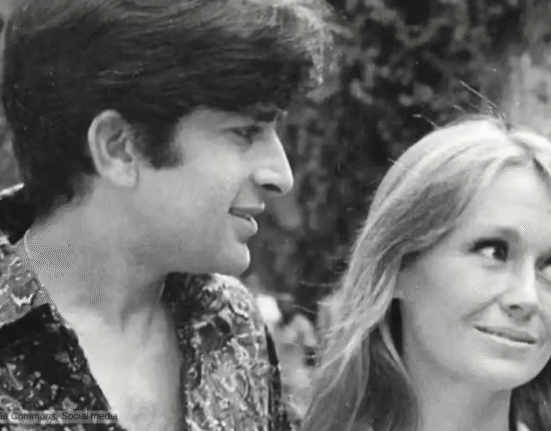The maestro behind the lens, Venkatarama Pandit Krishnamurthy, fondly known as VK Murthy (1923-2014) was a magician who gave us films like Sahib Bibi Aur Ghulam (1962), Chaudhvin Ka Chand (1960), Kaagaz Ke Phool (1959), Pyaasa and Many More.
VK Murthy carved his niche and left a permanent mark in Indian cinematography, especially during the black and white film era. He brought modern cinematic aesthetics to the frames, earning him the moniker ‘The Murthy Effect’ for his innovative close-up shots. His approach to film lighting was revolutionary, defying conventional norms of well-lit scenes and instead embracing mood-driven illumination. Using diffusers not just to soften images but to enrich them, Murthy showcased a remarkable range from the vibrant palette of comedies like ‘Mr. And Mrs. 55’ (1955) to the nuanced play of light and shadow in emotionally charged films like ‘Pyaasa’ (1957) and ‘Kaagaz Ke Phool’ (1959).
A pioneer in his field, Murthy was the first Indian cinematographer to explore CinemaScope, a wide-screen format. His outstanding black and white cinematography earned him the prestigious “Dadasaheb Phalke Award” in 2008.
Early Life
Born on November 26, 1923, in Mysore, Murthy’s journey began with a foundation in music and violin training. An impassioned teenager, he even served a five-month jail term in 1943 during the Indian freedom struggle. After completing his cinematography diploma from the Polytechnic Institute in Madras, Murthy faced the hurdles of securing a job in a camera unit. To make ends meet, he played the violin for film songs. His breakthrough came when he became an assistant to the esteemed Fali Mistry, eventually establishing himself as an independent cameraman with Guru Dutt.
VK Murthy The Master of Light and Shadows

VK Murthy’s career in films began modestly with Maharana Prathap (1946) but it was his collaboration with the legendary director Guru Dutt that catapulted him to fame. Murthy’s work as Dutt’s chief cinematographer on films like Jaal (1952) and Baazi (1951) showcased his ability to capture emotion and narrative through his lens. However, it was the 1959 film Kaagaz Ke Phool that became a critical success and is often hailed as one of the best examples of Murthy’s cinematographic genius. The film was India’s first cinemascope film, and Murthy’s work won him the Filmfare Award for Best Cinematographer.
Murthy’s collaboration with Guru Dutt produced some of the most iconic films in Indian cinema, including Aar Paar,” “Pyaasa,” “Chaudhavin Ka Chand” and “Sahib Bibi Aur Ghulam,” and His ability to use light and shadow to convey complex emotions and his innovative camera techniques were groundbreaking.
Kaagaz Ke Phool
Then came Kaagaz Ke Phool in 1959, India’s first film shot in CinemaScope. This film, often considered ahead of its time, tells the story of a director’s fall from grace and his unrequited love. VK Murthy’s work in Kaagaz Ke Phool is revolutionary, utilizing the wide canvas of CinemaScope to create a visual language that was unparalleled in Indian cinema. The film’s famous song ‘Waqt Ne Kiya’, featuring Waheeda Rehman under a spotlight amidst a sea of darkness, showcases Murthy’s ability to craft images that are both evocative and iconic.

Sahib, Biwi Aur Ghulam
The 1962 classic “Sahib, Bibi Aur Ghulam” is not only celebrated for its compelling narrative and powerful performances but also for its remarkable cinematography. The man behind the lens, VK Murthy, crafted visuals that were innovative for their time and contributed significantly to the film’s lasting legacy.
Murthy’s use of lighting and composition in “Sahib, Biwi Aur Ghulam” is a study in the art of black-and-white filmmaking. He employed chiaroscuro lighting, a technique that uses strong contrasts between light and dark to achieve a sense of volume in modeling three-dimensional objects and figures. This technique is evident in the way he captures the characters and their surroundings, creating a moody and atmospheric setting that reflects the film’s somber themes.


Other Work
VK Murthy’s collaboration with other directors like Pramod Chakravarthy and Shyam Benegal, also produced significant works. Murthy continued to work till early 90s in films like Ziddi (1964), Love in Tokyo (1966), Suraj (1966), Naya Zamana (1971), Jugnu (1973), Nastik (1983), Kalyug Aur Ramayan (1987), Tamas(1987), Deedar (1992) and many more.
One of Murthy’s most acclaimed works in Kannada cinema is ‘Hoovu Hannu’, where he not only served as the cinematographer but also appeared in a role.
Later Years
In 2001, At the age of 80, VK Murthy relocated to Bangalore from Mumbai to retire at his home in Shankarapuram, Basavanagudi where he passed away at the age of 91 on April 7, 2014. He was married and had a daughter named Chhaya.
VK Murthy’s best work is a testament to his belief that every frame and every shot had a purpose, serving the story and the director’s vision. His dedication to the craft of cinematography and his innovative spirit have left a lasting impact on the art of filmmaking.
V. K. Murthy on IMDB









